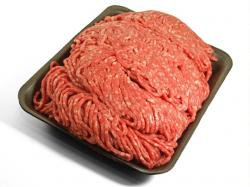Stricter Testing For Federal Ground Beef Program May Not Lead To Safer Meat
January 4, 2011 | 4 min to read

WASHINGTON — A new National Research Council report finds no scientific basis that more stringent testing of meat purchased through the government's ground beef purchase program and distributed to various federal food and nutrition programs — including the National School Lunch Program — would lead to safer meat.
The U.S. Department of Agriculture's Agricultural Marketing Service (AMS) buys ground beef from suppliers who must meet mandatory process, quality, traceback, and handling controls as well as comply with strict limitations on the amounts of bacteria in the meat, such as E. coli and salmonella. AMS then distributes the ground beef to federal programs, including food banks, emergency feeding programs, Indian reservations, and disaster relief agencies. In its assessment of AMS's ground beef purchase program, the committee that wrote the report said validated cooking processes provide greater assurance of ground beef's safety than would additional testing for pathogens. Testing alone cannot guarantee the complete absence of pathogens because of statistical implications associated with how beef is sampled during testing.
The committee's analysis of the number of illnesses since 1998 linked with AMS ground beef provided to schools suggests that outbreaks were rare events before AMS requirements became more stringent in February, implying that controls already in place were appropriate for protecting public health. For instance, no recorded outbreaks of E. coli or salmonella associated with AMS ground beef have occurred in more than a decade. Prevention of future outbreaks will depend on eliminating contamination during production and ensuring meat is properly handled, stored, and cooked before it is served, the committee emphasized.
As part of its review, the committee also attempted to compare the AMS specifications with those of large industry purchasers of ground beef. Among purchasers, the committee found considerable differences in testing and safety standards and suspected that the intended use of the ground beef could account for the variations. For example, all raw AMS ground beef is distributed in frozen form, but distributors of fresh meat products may require different standards designed to improve shelf life. While AMS safety requirements appear comparable to or more demanding than those of commercial companies on the surface, the lack of information detailing the science used for corporate specifications prevented the committee from making direct comparisons.
Additional specifications under the AMS program call for testing food samples and surfaces at the suppliers to look for the presence of "indicator" microorganisms that could denote unsanitary conditions, improper hygiene and processing techniques, post-processing contamination, and storage-temperature abuse. Although a reduction in the number of indicator organisms implies a reduction in the amount of pathogens, the presence of an indicator does not guarantee that a pathogen is also present, the committee said. For an indicator to be an effective predictor of a pathogen's presence, a statistical association needs to be established. Therefore, the committee recommended that AMS assess the usefulness of its microbiological data as a scientific basis for testing for indicators.
"The report encourages AMS to strengthen its established specifications and requirements for ground beef by utilizing a transparent and clearly defined science-based process," said Gary Acuff, chair of the committee and professor and director of the Center for Food Safety at Texas A&M University, College Station.
In addition, the report says that some of the requirements were founded on expert opinion and industry practices where the scientific basis was unclear. The committee recommended that AMS base their requirements on standards supported by the International Commission on Microbiological Safety of Foods, the Codex Alimentarius Commission, and the Research Council report An Evaluation of the Role of Microbiological Criteria for Foods and Food Ingredients. It also suggested that AMS analyze data from the suppliers' bacterial testing to evaluate the safety requirements over time and use statistical methods to set testing sample and lot sizes. Overall, AMS should develop a systematic, transparent, and auditable system for modifying, reviewing, updating, and justifying purchasing specifications.
The committee noted that maintaining people's confidence in the safety, quality, and nutritional value of the products AMS purchases is especially important because of the nature of the program and the clientele it serves. Though AMS may find it appropriate to adopt and implement conservative standards and requirements that both protect public health and provide the best quality product, it needs to consider the potential unintended consequences of increased testing and product requirements, the committee said. Additional testing would likely increase costs to producers, which could impact the purchase price of ground beef available through the program. Under such circumstances, schools might decide to buy their ground beef on the open market at a lower cost.
The report was sponsored by the U.S. Department of Agriculture. The National Academy of Sciences, National Academy of Engineering, Institute of Medicine, and National Research Council make up the National Academies. They are independent, nonprofit institutions that provide science, technology, and health policy advice under an 1863 congressional charter. Committee members, who serve pro bono as volunteers, are chosen by the Academies for each study based on their expertise and experience and must satisfy the Academies' conflict-of-interest standards. The resulting consensus reports undergo external peer review before completion. For more information, visit http://national-academies.org/studycommitteprocess.pdf. A committee roster follows.
Source: The National Academy of Sciences
